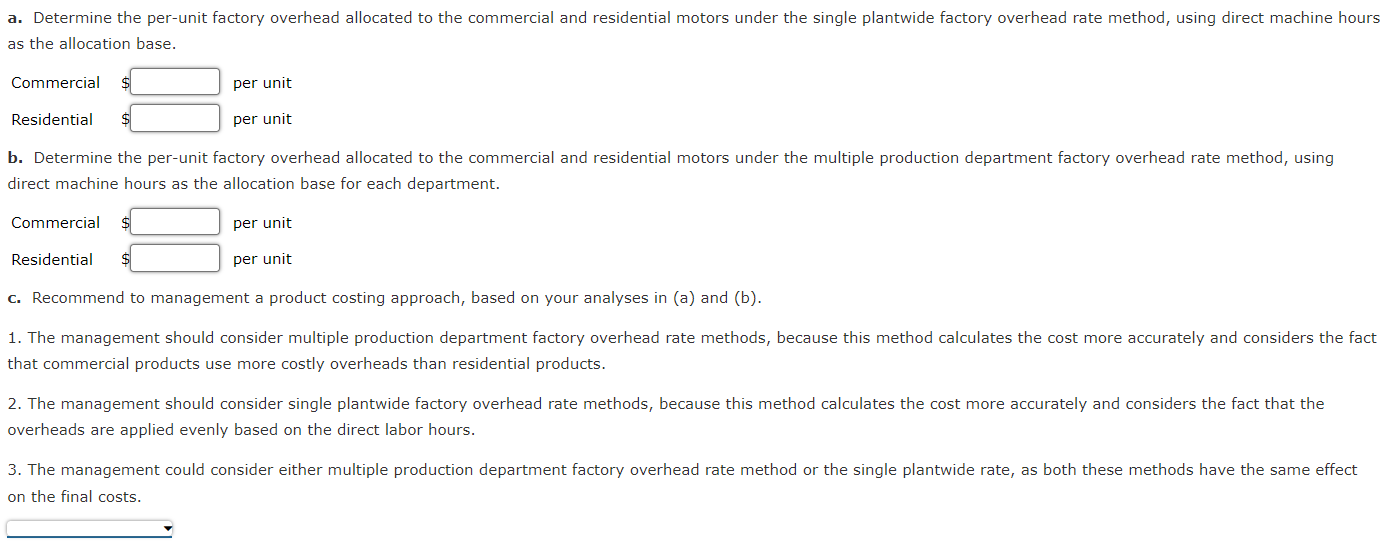Question
Eclipse Motor Company manufactures two types of specialty electric motors, a commercial motor and a residential motor, through two production departments, Assembly and Testing. Presently,
Eclipse Motor Company manufactures two types of specialty electric motors, a commercial motor and a residential motor, through two production departments, Assembly and Testing. Presently, the company uses a single plantwide factory overhead rate for allocating factory overhead to the two products. However, management is considering using the multiple production department factory overhead rate method. The following factory overhead was budgeted for Eclipse:
Assembly Department$280,000 Testing Department800,000 Total$1,080,000Direct machine hours were estimated as follows:
Assembly Department4,000hoursTesting Department5,000 Total9,000hoursIn addition, the direct machine hours (dmh) used to produce a unit of each product in each department were determined from engineering records, as follows:
CommercialResidentialAssembly Department2.0dmh3.0dmhTesting Department6.0 1.5 Total machine hours per unit8.0dmh4.5dmh a. Determine the per-unit factory overhead allocated to the commercial and residential motors under the single plantwide factory overhead rate method, using direct machine hours as the allocation base. CommercialResidential$$perunitperunit b. Determine the per-unit factory overhead allocated to the commercial and residential motors under the multiple production department factory overhead rate method, using direct machine hours as the allocation base for each department. CommercialResidential$$perunitperunit c. Recommend to management a product costing approach, based on your analyses in (a) and (b). 1. The management should consider multiple production department factory overhead rate methods, because this method calculates the cost more accurately and considers the fact that commercial products use more costly overheads than residential products. 2. The management should consider single plantwide factory overhead rate methods, because this method calculates the cost more accurately and considers the fact that the overheads are applied evenly based on the direct labor hours. 3. The management could consider either multiple production department factory overhead rate method or the single plantwide rate, as both these methods have the same effect on the final costs
a. Determine the per-unit factory overhead allocated to the commercial and residential motors under the single plantwide factory overhead rate method, using direct machine hours as the allocation base. CommercialResidential$$perunitperunit b. Determine the per-unit factory overhead allocated to the commercial and residential motors under the multiple production department factory overhead rate method, using direct machine hours as the allocation base for each department. CommercialResidential$$perunitperunit c. Recommend to management a product costing approach, based on your analyses in (a) and (b). 1. The management should consider multiple production department factory overhead rate methods, because this method calculates the cost more accurately and considers the fact that commercial products use more costly overheads than residential products. 2. The management should consider single plantwide factory overhead rate methods, because this method calculates the cost more accurately and considers the fact that the overheads are applied evenly based on the direct labor hours. 3. The management could consider either multiple production department factory overhead rate method or the single plantwide rate, as both these methods have the same effect on the final costs Step by Step Solution
There are 3 Steps involved in it
Step: 1

Get Instant Access to Expert-Tailored Solutions
See step-by-step solutions with expert insights and AI powered tools for academic success
Step: 2

Step: 3

Ace Your Homework with AI
Get the answers you need in no time with our AI-driven, step-by-step assistance
Get Started


